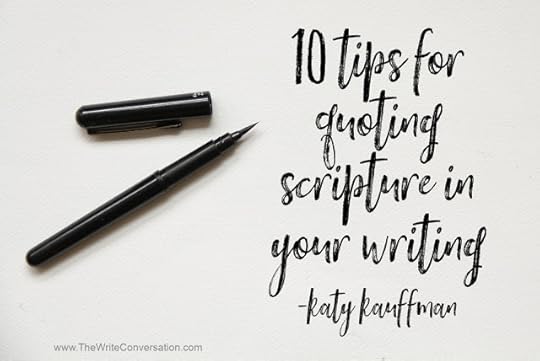10 Tips for Quoting Scripture in Your Writing

by Katy Kauffman @KatyKauffman28
There’s study mode, and then there’s writing mode. When we’re jotting down Bible verses in our spiritual journals, we normally don’t think about writing down the Bible translation. Or where the quotation marks go. Or if a period should be before the reference or after it. We’re in study mode, fixated on a verse’s beauty or power, and rightfully so. But when we quote Scripture in our writing, it’s not just about getting the words right, but remembering the correct formatting. Not because we’re legalistic or the punctuation police will come after us, but so we can help our readers. And our editors.When we format our Bible citations correctly, we help our readers to appreciate Scripture more. They will be able to look up a verse on their own in the translation we’ve used and enjoy it longer. It’s in many of these moments that I hear something special from God as I meditate on a verse an author has shared.
Also, when we remember the rules for citing Scripture, we make our writing less cluttered. Our punctuation won’t cause any distractions for our readers, some of whom may be our future editors. Some editors may want to use our work, but they don’t have the time (or manpower) to edit everything that is submitted. The more we can do on our own to prepare our writing for publication, the better chance we will have to be published and bless people’s hearts.
So when you quote Scripture, keep these formatting and citation tips in mind.1 They will make things easier on your editors and smoother for your readers.
10 Tips for Quoting ScriptionAlways, always, always give the Bible translation for the verses you quote. (Even on memes!)In running text (i.e., paragraph form), cite a Bible reference in the following way: “God is love” (1 John 4:8 NKJV). Notice there’s no comma within the parentheses, and the period goes after the ending parenthesis.If your Bible verse is longer than three or four lines, make it a block quote (all lines are indented on the left), and put the period at the end of the verse, so that it looks like this—“have everlasting life.” (John 3:16 NKJV)If you’re writing a book and using one translation most of the time, you can put a note on the copyright page and not mention the translation every time you use it. Look inside the Bible to see what language to use for the copyright information. For instance, our publishing company used the following note in one of our books: “Unless otherwise indicated, all Scripture references are taken from the New King James Version. Copyright © 1979, 1980, 1982 by Thomas Nelson, Inc. Used by permission. All rights reserved.” Some editors (like me) may allow you to mention the Bible translation once in an article or a devotion. When a translation is used often in an article, I put an asterisk after the first reference, like the following: “God is love” (1 John 4:8 NKJV*). Then at the end of the article, I make this note—“*All Scripture verses are taken from the NKJV unless otherwise noted.” If only one version is used, then I omit the “unless” phrase.On your book’s copyright page, remember to provide the correct copyright information for every Bible translation you have used. Look on the copyright page of your Bible translation to see how much of that version can be quoted without permission.In your writing, use quotation marks or italics to quote Scripture, but please don’t use both (unless someone is talking in part of the verse). Your publisher may suggest which to use, but whichever you pick, remember to be consistent. Please be sure to double-check the wording of Bible verses you quote (sometimes we remember them differently than a translation states them), and double-check the punctuation.If you start quoting in the middle of a verse, you don’t have to put an ellipsis at the beginning of the quote. If you leave off the end of a verse, you don’t have to use an ellipsis to show that. But do use it to show something has been left out of the middle of a verse, and remember to put a space on either side of the ellipsis.
At this point, you may think, Nope, I just wanted to quote Scripture. I’m with you. It can be a lot to remember. Or these may be things you’ve been practicing for years. Once I understood the rules, these tips became second nature, and it was easier to honor the wonderful, sacred text that Scripture is.
What Bible translation do you use the most, and were any of these tips new to you? I’d like to read your comments below, so be sure to join the conversation!
1 Note: These tips are taken from The Chicago Manual of Style.
TWEETABLE10 Tips for Quoting Scripture in Your Writing - @KatyKauffman28 on @EdieMelson (Click to Tweet)
 Katy Kauffman is an award-winning author, an editor of
Refresh Bible Study Magazine
, and a co-founder of Lighthouse Bible Studies. She loves connecting with writers and working alongside them in compilations, such as Feed Your Soul with the Word of God, Collection 1 which is a 2020 Selah Awards finalist. Lighthouse’s newest compilation, The Power to Make a Difference, released January 2020.
Katy Kauffman is an award-winning author, an editor of
Refresh Bible Study Magazine
, and a co-founder of Lighthouse Bible Studies. She loves connecting with writers and working alongside them in compilations, such as Feed Your Soul with the Word of God, Collection 1 which is a 2020 Selah Awards finalist. Lighthouse’s newest compilation, The Power to Make a Difference, released January 2020. In addition to online magazines, Katy’s writing can be found at CBN.com, thoughts-about-God.com, the Arise Daily blog, and two blogs on writing. She loves spending time with family and friends, making jewelry, and hunting for the best donuts. Connect with her at her blog, The Scrapbooked Bible Study , and on Facebook and Twitter.
Published on March 17, 2020 22:00
No comments have been added yet.



